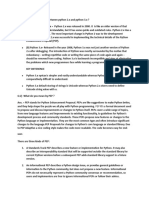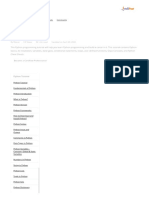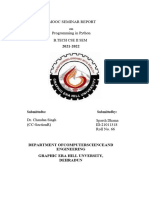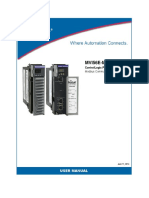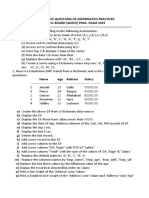Assignment 1
Uploaded by
Pradeepth S JainAssignment 1
Uploaded by
Pradeepth S Jain1. Difference between Python 2.x and 3.
Ans. Python 2.x and Python 3.x are two major versions of Python, with Python 3.x being a more
modern iteration. Python 2.x is legacy software and is no longer actively maintained as of
January 1, 2020. One key difference is the handling of strings: in Python 2.x, strings are ASCII by
default, while Python 3.x uses Unicode, which makes it more versatile for modern applications.
The print statement in Python 2.x was changed to a print() function in Python 3.x, making the
syntax consistent with other functions. Additionally, Python 3.x introduced features like better
integer division using the // operator and improved error handling. Overall, Python 3.x
encourages cleaner and more future-proof code.
2. What do you mean by PVM? Explain
Ans. PVM stands for Python Virtual Machine. It is a part of Python’s runtime environment
responsible for executing the compiled Python bytecode. When Python code is executed, it is first
converted into intermediate bytecode by the Python interpreter, which is then executed by the PVM.
The PVM is platform-independent and ensures Python code runs uniformly across different operating
systems.
3. What is the difference between compiler and interpreter?
Ans. A compiler translates the entire source code of a program into machine code before
execution, whereas an interpreter translates and executes the code line by line. Compilers are
generally faster in execution since the entire code is pre-compiled, but errors are harder to debug
because they are reported after compilation. Interpreters, on the other hand, provide immediate
feedback for errors, making debugging easier but at the cost of slower execution due to real-time
interpretation. Compilers are better for applications requiring high performance, as they produce
optimized machine code. Interpreters are more suitable for development and scripting environments
where immediate feedback and portability are prioritized. Python, for example, uses an interpreter,
making it excellent for rapid prototyping and scripting.
4. What are the different keywords in python?
Ans. Keywords in Python are reserved words that have specific meanings and cannot be used as
identifiers. Examples include if, else, while, for, def, return, class, try, except, True, False, and None.
As of Python 3.10, there are 36 keywords, and they are case-sensitive.
5. What is PEP in Python?
Ans. PEP stands for Python Enhancement Proposal. It is a design document providing information to
the Python community or describing new features for Python. PEPs are critical in the decision-
making process for Python’s evolution, ensuring transparency and collaboration among developers.
6. Difference between PEP 8 and PEP 9
Ans. PEP 8 is the style guide for Python code, outlining conventions for code layout, naming, and
formatting to ensure consistency and readability. It focuses on aspects like indentation, line length,
and naming conventions. PEP 9, on the other hand, is a document detailing guidelines for proposing
and maintaining Python library modules. It is less about coding style and more about the structure
and lifecycle of library modules within Python’s ecosystem.
You might also like
- Hourglass Workout Program by Luisagiuliet 276% (21)Hourglass Workout Program by Luisagiuliet 251 pages
- The Hold Me Tight Workbook - Dr. Sue Johnson100% (16)The Hold Me Tight Workbook - Dr. Sue Johnson187 pages
- Read People Like A Book by Patrick King-Edited62% (66)Read People Like A Book by Patrick King-Edited12 pages
- Livingood, Blake - Livingood Daily Your 21-Day Guide To Experience Real Health77% (13)Livingood, Blake - Livingood Daily Your 21-Day Guide To Experience Real Health260 pages
- COSMIC CONSCIOUSNESS OF HUMANITY - PROBLEMS OF NEW COSMOGONY (V.P.Kaznacheev,. Л. V. Trofimov.)94% (212)COSMIC CONSCIOUSNESS OF HUMANITY - PROBLEMS OF NEW COSMOGONY (V.P.Kaznacheev,. Л. V. Trofimov.)212 pages
- Donald Trump & Jeffrey Epstein Rape Lawsuit and Affidavits83% (1016)Donald Trump & Jeffrey Epstein Rape Lawsuit and Affidavits13 pages
- The 36 Questions That Lead To Love - The New York Times94% (34)The 36 Questions That Lead To Love - The New York Times3 pages
- The 36 Questions That Lead To Love - The New York Times95% (21)The 36 Questions That Lead To Love - The New York Times3 pages
- Jeffrey Epstein39s Little Black Book Unredacted PDF75% (12)Jeffrey Epstein39s Little Black Book Unredacted PDF95 pages
- The 4 Hour Workweek, Expanded and Updated by Timothy Ferriss - Excerpt23% (954)The 4 Hour Workweek, Expanded and Updated by Timothy Ferriss - Excerpt38 pages
- 2.system Configuration Hardware Requirements: Processor Intel Pentium 3805u @1.90ghzNo ratings yet2.system Configuration Hardware Requirements: Processor Intel Pentium 3805u @1.90ghz51 pages
- Turritopsis Dohrnii Teo en Ming's Book 2 (Edition 20220815)No ratings yetTurritopsis Dohrnii Teo en Ming's Book 2 (Edition 20220815)554 pages
- UNIT 1 Solution Python Programming QUESTION BANK 2023-24No ratings yetUNIT 1 Solution Python Programming QUESTION BANK 2023-2419 pages
- Introduction To Python: A Readable, Dynamic, Pleasant, Flexible, Fast and Powerful LanguageNo ratings yetIntroduction To Python: A Readable, Dynamic, Pleasant, Flexible, Fast and Powerful Language71 pages
- python programming question bank unit wise by Rupesh ✓No ratings yetpython programming question bank unit wise by Rupesh ✓24 pages
- 3 Introduction To Python: National Research Institute For Mathematics and Computer ScienceNo ratings yet3 Introduction To Python: National Research Institute For Mathematics and Computer Science48 pages
- Computer Programming Language: Introduction To PYTHONNo ratings yetComputer Programming Language: Introduction To PYTHON11 pages
- Unit_I_Introduction_and_Syntax_of_Python_Program[1]No ratings yetUnit_I_Introduction_and_Syntax_of_Python_Program[1]21 pages
- Workshop On Python Programming: By: Sumanta BiswasNo ratings yetWorkshop On Python Programming: By: Sumanta Biswas111 pages
- Python Programming For Beginners: Python Programming Language TutorialFrom EverandPython Programming For Beginners: Python Programming Language TutorialNo ratings yet
- Top 50+ Python Interview Questions and Answers (Latest 2024)No ratings yetTop 50+ Python Interview Questions and Answers (Latest 2024)14 pages
- ACI Worldwide - Company Research DocumentNo ratings yetACI Worldwide - Company Research Document3 pages
- Intro: Step 1: Export From Marvelous DesignerNo ratings yetIntro: Step 1: Export From Marvelous Designer3 pages
- System Integration and Architecture 20-MCQ'SNo ratings yetSystem Integration and Architecture 20-MCQ'S2 pages
- Catchlogs - 2024-04-07 at 01-43-40 - 7.60.0 - .JavaNo ratings yetCatchlogs - 2024-04-07 at 01-43-40 - 7.60.0 - .Java52 pages
- Software Release Version 10.6 For Microsoft Windows: Public DocumentationNo ratings yetSoftware Release Version 10.6 For Microsoft Windows: Public Documentation7 pages
- Buy RYZEN 7 3700X 4.4GHz GT 1030 2GB Desktop PC at Evetech - Co.zaNo ratings yetBuy RYZEN 7 3700X 4.4GHz GT 1030 2GB Desktop PC at Evetech - Co.za1 page
- 11 - AIOPS Specialist Enablement - Capstone Exercise V1.0No ratings yet11 - AIOPS Specialist Enablement - Capstone Exercise V1.014 pages
- I. Explain P (Deterministic Polynomial Time) Problems With A Suitable ExampleNo ratings yetI. Explain P (Deterministic Polynomial Time) Problems With A Suitable Example2 pages



































